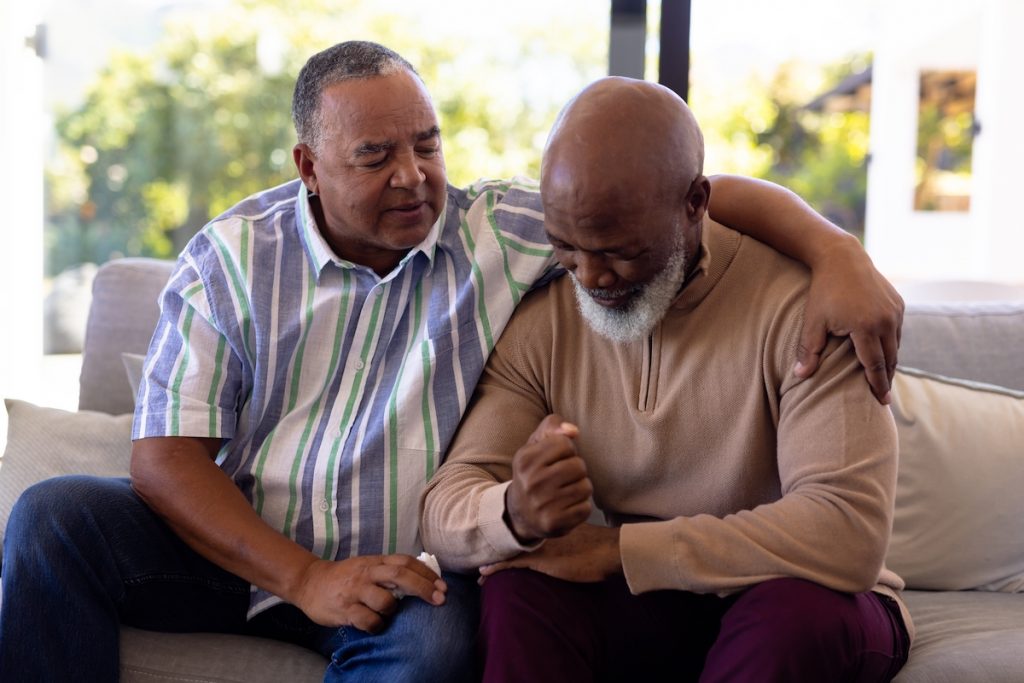
In many nations worldwide, men take their lives at three times the rate of women (Turecki et al., 2019). While mental illness is a clear risk factor for suicide in men (Richardson et al., 2021), a significant proportion of suicides in men are linked to psychosocial stressors including employment issues, housing difficulties and relationship breakdown, which can trigger defeat and entrapment (Bennett et al., 2022). For example, in the latest Australian suicide data, relationship issues including separation and divorce were the most common risk factor for suicide in men aged 25-44; replacing mood disorders for the first time (ABS, 2023).
Advocates for male suicide prevention often discuss the need to normalise and encourage men’s self-disclosure and help-seeking from mental health services in the event of a crisis. A previous Mental Elf blog discussed the challenges linked to the rhetorical encouragement of men to “just talk” as a suicide prevention initiative (Richardson, 2021). This neglects the structural barriers to men’s help-seeking and encourages us to reflect more on the support we are providing to men, rather than placing full responsibility for men’s mental health promotion on their shoulders. Similar issues are raised when it comes to mental health services for men. These typically focus on addressing mental ill-health as an avenue to suicide prevention. Yet situational stressors can clearly drive suicidality in men (Ibrahim et al., 2019), sometimes in the absence of co-occurring mental illness (Fowler et al., 2022).
The Hope service, evaluated in a new study by Farr and colleagues (2023), aims to directly address these factors as determinants of suicidality in men. The Hope service (originally termed Help fOr People with money, Employment, benefit or housing problems) provides psychosocial and practical support for men aged 30-64 at risk of suicide. Building on prior pilot evidence of the feasibility and acceptability of the service, this qualitative study “aimed to evaluate the acceptability and usefulness of Hope from service user, staff and referrer perspectives, to understand how the Hope service supports men at risk of suicide and the factors that influence its impact.”

Life stressors such as job loss and relationship breakdown can be key triggers for suicidality in men.
Methods
This is a cross-sectional, qualitative study based on semi-structured interviews with Hope service users, project workers, advice workers and managers, alongside NHS staff who carry out referrals to the HOPE service. Purposeful sampling of service users occurred to achieve a diverse range of participants. Pragmatic convenience sampling was applied in recruiting staff members. Interview questions are provided in the study appendix and cover a comprehensive range of areas of potential impact of the HOPE service.
Transcribed interviews were analysed using established thematic analysis methods. The authors report the involvement of former HOPE service users in advisory roles on the project, although their impact is not discussed in depth. However, the authors do not reflect on or consider the relationship between themselves as researchers and the participants.
Results
Across 26 qualitative interviews with 16 service users, 6 HOPE staff, 2 advice workers and 2 NHS staff, the following themes were generated to reflect the data.
Engaging with unmet needs
The first theme (The Hope service – engaging with unmet needs) details the many and varied circumstances in which service users initially presented to Hope. This reflected a diverse range of psychosocial stressors, including addiction, employment or financial issues, interpersonal problems and relationship breakdown. Participant quotes highlight the gap in services for men presenting in crisis, but who are not deemed “bad enough to be admitted to the psychiatric unit”, so are referred to their GP for community counselling (which they will typically only receive after lengthy waiting periods). The Hope service seems to address this gap for some men navigating crises not deemed severe enough for psychiatric admission.
Creating a supportive space
Service users also reported comfort in accessing Hope as this service felt suitable for men. Several elements discussed in the second theme (creating a supportive space) draw on established models of gender-sensitised health service provision for men (Seidler et al., 2022). Providing tangible support grounded in non-judgmental, shared decision-making between service providers and users seemed to be critical to engagement. Service users discussed feeling profoundly destabilised by the stressors they were experiencing (e.g., housing or debt issues). For many, the Hope service was a critical “anchor” that enabled them to regain a sense of control, de-escalate their crisis, and in some cases prevent suicide.
Specialist advice services
Hope appeared distinctive in its capacity to link service users to advice workers with specialist expertise in navigating stressors, discussed in the third theme (specialist advice services). This is critical in ensuring timely and targeted suicide prevention, given external advice is typically limited by lengthy waitlists. For example, the advice workers clearly met a need for men whose suicidal crises were triggered by financial issues, as “they were funded to work with Hope service users until their problems were resolved”, without limits on the number of sessions available.
Across the remaining themes, the clear suicide prevention potential of embedding addiction support services alongside practical and emotional support was also indicated. The service also provided space for men with histories of trauma and/or abuse to begin a journey towards healing once their immediate crises were resolved. In all, the results of this study suggest the diversity of impacts of the Hope service, and the clear value some men in crisis place on resolving the immediate, practical issues at hand.

The right combination of emotional and immediate, practical support can prevent men’s suicide.
Conclusions
Suicide prevention is often focused on addressing mental ill-health as a primary cause of suicidality. Yet it is common for men to experience suicidality following significant life stressors in the absence of any co-occurring or prior mental health issues. Psychosocial stressors such as job loss or relationship breakdown can be profoundly destabilising, necessitating the right balance of tangible, immediate, practical and emotional support.
This study highlights the value of services that centre men’s immediate practical support needs and prioritise the necessary directions to help men steer themselves through a crisis.

The evaluation of the Hope service indicates that many men in crisis value being provided the path to steer themselves through the storm.
Strengths and limitations
Strengths of this study include its focus on recruitment not only of service users but also service providers. Prior research has highlighted the alienation some men feel in counselling environments that do not feel ‘male friendly’ (Seidler et al., 2016). Mental health practitioners also commonly report difficulties engaging men, particularly men in crisis (Seidler et al., 2021). The results provided in this study include both perspectives and highlight the potential for service effectiveness if clearly targeted to clients’ needs. The authors also cite the inclusion of lived experience input from prior service users; however, it is somewhat unclear as to how this input was meaningfully incorporated into the analysis and/or results.
The authors discuss some reasonable limitations of their study. These include sampling bias, where results may be tilted towards favourably representing the Hope service; users who had disengaged from the service (potentially due to negative experiences) were not available for input. The sample of service users is also demographically homogenous (as noted by the authors). Beyond this, the composition of the service user sample is unclear in terms of users’ concurrent and/or prior histories of mental health problems. Understanding how many participants presented to Hope in the absence of prior mental health concerns would have been useful information for the readers, in evaluating the value of the Hope service for men whose suicidality appears primarily situational and/or impulsive, and not a feature of mental illness.
The rigour of the analysis could be described in greater depth. In particular, the authors do not discuss the potential influence of the interviewing and analysing researchers in co-constructing the results observed due to their own subjectivities and biases. Reflexivity is a key component of thematic analysis, which encourages researchers to acknowledge their role in co-constructing one subjective truth from the data, rather than identifying the objective truth of the data (Braun & Clarke, 2019). For example, the interviewing and/or analysing researchers’ prior biases or assumptions regarding men’s suicidality may have influenced the steering of interviews and analysis, subsequently directing the findings observed. The analysis applied is appropriate, but its description and depth could have been improved through a thoughtful discussion of reflexivity. In addition, the authors describe the framework analysis method of thematic analysis, but details regarding the application of a data-driven coding framework are not presented in depth. Qualitative evaluations of services such as Hope are essential to understanding the potential mechanisms underlying their impact. As such, including more analytical detail would have aided future researchers who may be able to draw on or adapt this methodology.

Considering the role of researchers in constructing findings is critical to depth in qualitative research.
Implications for practice
The evidence presented in this paper supports the growing recognition of men’s suicidality as an often-impulsive response to a significant life stressor, sometimes in the absence of concurrent or prior mental ill-health. Mental health practitioners must centre the immediate needs expressed by men in crisis.
Prior research focusing on challenges experienced by mental health practitioners in working with men highlights common frustrations in men’s reticence to focus on the ‘deeper issues’ that might be underlying the gravity of their response to, for example, loss of employment (Seidler et al., 2021). For some help-seeking men, it may feel dismissive if practitioners position a situational stressor and its’ associated suicidality as symptoms of a deeper issue. The evidence in this article suggests the suicide prevention potential of prioritising the issue at hand and helping men solve problems with practical advice first, before addressing any underlying psychological issues that may have exacerbated the crisis.

Suicide prevention strategies can focus on tangible assistance with life stressors such as financial issues, job loss and relationship breakdown.
Statement of interests
My broad area of research is men’s mental health and suicide prevention. I am currently investigating the role of situational stressors such as relationship breakdown in male suicide, and have previously worked on research focused on sensitising mental health services for men.
Links
Primary paper
Other references
Australian Bureau of Statistics. Causes of Death, Australia, 2022. Published online 2023. Accessed October 19, 2023.
Bennett S, Robb KA, Zortea TC, Dickson A, Richardson C, O’Connor RC. Male suicide risk and recovery factors: A systematic review and qualitative metasynthesis of two decades of research. Psychological Bulletin. 2023 Jul;149(7-8):371. https://psycnet.apa.org/doi/10.1037/bul0000397
Braun V, Clarke V. Reflecting on reflexive thematic analysis. Qualitative research in sport, exercise and health. 2019 Aug 8;11(4):589-97. https://doi.org/10.1080/2159676X.2019.1628806
Fowler KA, Kaplan MS, Stone DM, Zhou H, Stevens MR, Simon TR. Suicide Among Males Across the Lifespan: An Analysis of Differences by Known Mental Health Status. Am J Prev Med. 2022;63(3):419-422. https://doi.org/10.1016/j.amepre.2022.02.021
Ibrahim S, Hunt IM, Rahman MS, Shaw J, Appleby L, Kapur N. Recession, recovery and suicide in mental health patients in England: time trend analysis. The British Journal of Psychiatry. 2019 Oct;215(4):608-14. https://doi.org/10.1192/bjp.2019.119
Richardson C. Male suicide prevention: uncovering the challenges associated with “talking”. The Mental Elf, 3 Nov 2021. https://www.nationalelfservice.net/mental-health/suicide/male-suicide-prevention/
Richardson C, Robb KA, O’Connor RC. A systematic review of suicidal behaviour in men: A narrative synthesis of risk factors. Social Science & Medicine. 2021 May 1;276:113831. https://doi.org/10.1016/j.socscimed.2021.113831
Seidler ZE, Dawes AJ, Rice SM, Oliffe JL, Dhillon HM. The role of masculinity in men’s help-seeking for depression: a systematic review. Clinical psychology review. 2016 Nov 1;49:106-18. https://doi.org/10.1016/j.cpr.2016.09.002
Seidler ZE, Wilson MJ, Owen J, Oliffe JL, Ogrodniczuk JS, Kealy D, Rice SM. Teaching gender competency with men in mind: Foundations of an online training program for mental health practitioners. The Journal of Men’s Studies. 2022 Mar;30(1):111-31. https://doi.org/10.1177/10608265211035941
Seidler ZE, Wilson MJ, Trail K, Rice SM, Kealy D, Ogrodniczuk JS, Oliffe JL. Challenges working with men: Australian therapists’ perspectives. Journal of Clinical Psychology. 2021 Dec;77(12):2781-97. https://doi.org/10.1002/jclp.23257
Turecki G, Brent DA, Gunnell D, et al. Suicide and suicide risk. Nature Reviews Disease Primers 2019 5:1. 2019;5(1):1-22. https://doi.org/10.1038/s41572-019-0121-0
Photo credits
- Photo by Karl Fredrickson on Unsplash
- Photo by charlesdeluvio on Unsplash
- Photo by Tyler Nix on Unsplash
